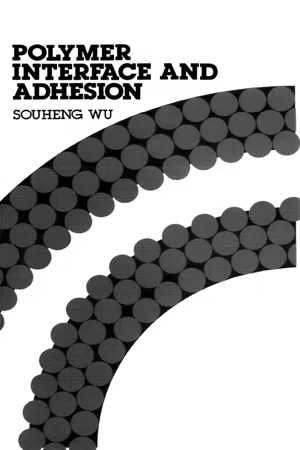
- 630 pages
- English
- ePUB (mobile friendly)
- Available on iOS & Android
Polymer Interface and Adhesion
About This Book
Poly mer Interface and Adhesion provides the critical basis for further advancement in thisfield. Combining the principles of interfacial science, rheology, stress analysis, and fracturemechanics, the book teaches a new approach to the analysis of long standing problemssuch as: how is the interface formed; what are its physical and mechanical properties;and how does the interface modify the stress field and fracture strength of the material.The book offers many outstanding features, including extensive listings of pertinent references, exhaustive tabulations of the interfacial properties of polymers, critical reviews ofthe many conflicting theories, and complete discussions of coupling agents, adhesion promotion, and surface modifications. Emphasis is placed on physical concepts and mechanisms, using clear, understandable mathematics.Polymer Interface and Adhesion promotes a more thorough understanding of the physical, mechanical, and adhesive properties of multiphase, polymer systems. Polymer scientistsand engineers, surface chemists, materials scientists, rheologists, as well as chemical andmechanical engineers interested in the research, development or industrial applications ofpolymers, plastics, fibers, coatings, adhesives, and composites need this important newsource book.
Frequently asked questions
Table of contents
- Cover Page
- Half title
- Title Page
- Copyright Page
- Dedication
- Preface
- Acknowledgments
- Contents
- 1 Interfacial Thermodynamics
- 2 Molecular Interpretations
- 3 Interfacial and Surface Tensions of Polymer Melts and Liquids
- 4 Contact Angles of Liquids on Solid Polymers
- 5 Surface Tension and Polarity of Solid Polymers
- 6 Wetting of High-Energy Surfaces
- 7 Dynamic Contact Angles and Wetting Kinetics
- 8 Experimental Methods for Contact Angles and Interfacial Tensions
- 9 Modifications of Polymer Surfaces: Mechanisms of Wettability and Bondability Improvements
- 10 Adhesion: Basic Concept and Locus of Failure
- 11 Formation of Adhesive Bond
- 12 Weak Boundary Layers
- 13 Effect of Internal Stress on Bond Strength
- 14 Fracture of Adhesive Bond
- 15 Creep, Fatigue, and Environmental Effects
- Appendix I: Calculation of Surface Tension and Its Nonpolar and Polar Components from Contact Angles by the Harmonic-Mean and the Geometric-Mean Methods
- Appendix II: Unit Conversion Tables
- Index